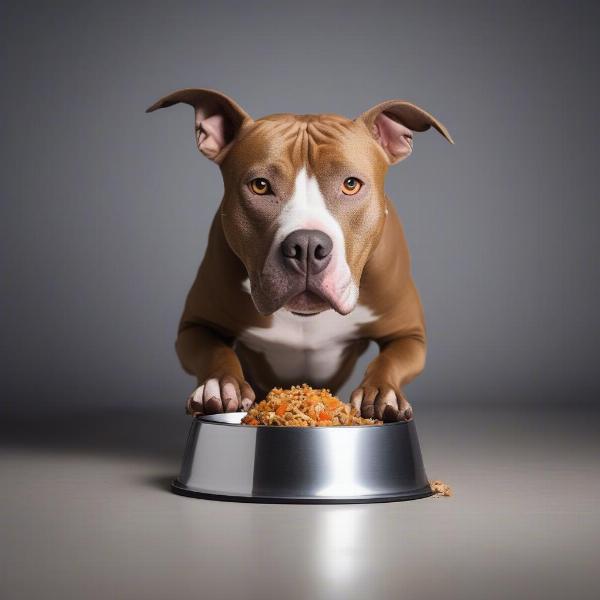The term “pitbull big dog” often conjures images of a powerful, intimidating canine. While American Pit Bull Terriers (APBTs) are certainly strong and athletic, their size is often misrepresented. This article will delve into the reality of the APBT’s size, dispelling myths and providing accurate information about this often misunderstood breed. We’ll explore their physical characteristics, temperament, training needs, and responsible ownership, helping you understand what truly makes a Pit Bull a “big dog”.
Debunking the “Big Dog” Myth: Pitbull Size and Standards
While the term “big dog” is subjective, the American Pit Bull Terrier is technically classified as a medium-sized breed. According to the United Kennel Club (UKC), the standard weight for male APBTs is between 35 and 60 pounds, while females range from 30 to 50 pounds. Their height typically ranges from 18 to 21 inches at the shoulder. While some individuals may fall outside these ranges, these standards represent the average size of a well-bred APBT. It’s important to note that other breeds often mistakenly labeled as “pitbulls,” like the American Staffordshire Terrier and Staffordshire Bull Terrier, have similar size standards.
More Than Just Size: Defining “Big” in a Pitbull
“Big” can mean more than just physical size when it comes to Pit Bulls. Their personalities are often larger than life. They are known for their energy, enthusiasm, and unwavering loyalty to their families. This “big” personality requires responsible ownership, including proper training and socialization to ensure they become well-adjusted companions.
Training Your “Big” Personality Pitbull: Essential for a Happy Life
A well-trained Pit Bull is a happy Pit Bull. Their intelligence and eagerness to please make them highly trainable, but their strength and energy require a consistent and positive approach. Early socialization is crucial to ensure they develop into well-rounded adults who are comfortable around other dogs and people. Obedience training, starting from puppyhood, is essential to establish clear boundaries and ensure a harmonious relationship between dog and owner.
Focusing on Positive Reinforcement
Positive reinforcement methods, such as rewarding desired behaviors with treats and praise, are highly effective with Pit Bulls. Avoid harsh training techniques, which can damage their trust and potentially lead to behavioral issues. Consistency and patience are key to success.
“Building a strong bond with your Pit Bull through positive reinforcement training is the foundation for a fulfilling and joyful relationship,” says renowned dog trainer, Sarah Miller, CPDT-KA.
Nourishing Your Pitbull: Fueling Their Big Energy
A healthy diet is crucial for maintaining a Pit Bull’s physical and mental well-being. High-quality dog food formulated for active breeds will provide the necessary nutrients to support their energetic lifestyle. Consult with your veterinarian to determine the appropriate portion sizes and feeding schedule for your individual dog’s needs.
 Pitbull eating from a bowl
Pitbull eating from a bowl
Conclusion: Embracing the True Meaning of “Pitbull Big Dog”
The term “pitbull big dog” encompasses more than just physical size. It represents the breed’s strength, loyalty, and vibrant personality. While their size falls within the medium range, their presence and character are undeniably “big.” By understanding their unique needs and committing to responsible ownership, you can ensure a happy and fulfilling life for your Pit Bull companion.
FAQ:
-
How big do Pit Bulls actually get? Pit Bulls are typically classified as a medium-sized breed, with males weighing 35-60 pounds and females 30-50 pounds.
-
Are Pit Bulls aggressive? Pit Bulls, like any dog, can exhibit aggression if not properly socialized and trained. Responsible ownership is crucial to ensuring they become well-adjusted companions.
-
What is the best way to train a Pit Bull? Positive reinforcement methods, rewarding desired behaviors with treats and praise, are highly effective with Pit Bulls.
-
What kind of food should I feed my Pit Bull? High-quality dog food formulated for active breeds is recommended. Consult with your veterinarian for specific dietary recommendations.
-
Are Pit Bulls good family dogs? With proper training and socialization, Pit Bulls can make loving and loyal family pets.
-
How much exercise does a Pit Bull need? Pit Bulls are energetic dogs and require regular exercise to stay healthy and happy.
-
Where can I find more information about responsible Pit Bull ownership? Reputable breed-specific rescue organizations and experienced trainers can provide valuable information and support.
ILM Dog is your trusted source for expert advice on all aspects of dog care, from breed selection to health, training, and nutrition. We offer practical, evidence-based information to help you provide the best possible care for your furry friend. Whether you’re a seasoned dog owner or just starting out, we have the resources you need to navigate the joys and challenges of dog ownership. Explore our website for more insightful articles and tips on caring for your beloved canine companion. For personalized guidance, reach out to our team of experts at [email protected] or call us at +44 20-3965-8624. ILM Dog is here to support you every step of the way.